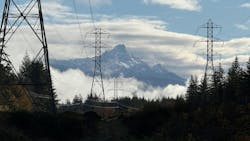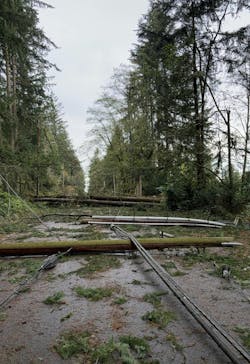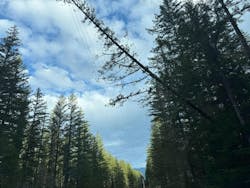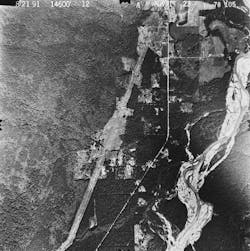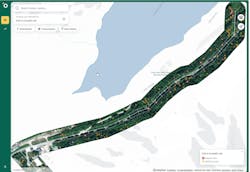LiDAR and AI Reshape Risk Management for Seattle City Light
For decades, utilities have approached vegetation management with a predictable cycle — assess, trim, repeat. While effective at preventing some outages, this method has long relied on broad assumptions rather than precise risk-based data. The result? Utilities are spending resources on trimming trees that pose no imminent threat while hazardous trees remain undetected until it’s too late.
The energy sector is now at an inflection point. Technologies including LiDAR, AI-powered analytics and real-time satellite monitoring are reshaping how utilities manage vegetation-related risks. Instead of reacting to outages or conducting static, scheduled maintenance, utilities can now predict and prevent failures before they happen — fundamentally shifting how grid reliability is managed.
Seattle City Light (SCL) is exploring this transition by integrating data-driven tools to modernize its approach to vegetation management. By combining older technology like aerial imaging and LiDAR scans with satellite imagery and AI-powered risk modeling, the utility is working to move beyond cycle-based trimming toward a dynamic, risk-prioritized strategy. The shift is not only about improving reliability but also about optimizing spending, reducing emergency response costs and minimizing wildfire risks.
Vegetation management is only the starting point. What if utilities could layer LiDAR and AI-powered vegetation risk assessments with weather modeling, historical outage data and infrastructure condition monitoring to create a truly predictive operational system? As utilities begin integrating multiple data streams, the potential for a smarter, more resilient grid becomes clear. This isn’t just about managing trees; it’s about managing risk intelligently.
Beyond LiDAR
LiDAR has revolutionized vegetation management by providing high-resolution, three-dimensional scans of transmission corridors. These surveys capture precise details about trees, power lines and structures, enabling utilities to assess encroachments and clearance violations with accuracy never before possible. But LiDAR alone isn’t enough.
Even with frequent flyovers, LiDAR data is static — it captures a moment in time. A tree might look stable in a scan today, but unseen stress factors like disease, drought or soil erosion could cause it to fail weeks later. By the time the next scheduled assessment comes around, the damage may already be done.
To bridge this gap, utilities are now combining LiDAR with real-time satellite monitoring, AI-powered analytics and historical reliability data. SCL is actively exploring how to layer these data streams to improve risk prediction. This includes:
- AI-driven risk assessments. Machine learning models analyze tree species and environmental conditions to predict which trees are most likely to cause failures. This can better identify vegetation stress indicators such as declining tree health, rapid die-off or shifting soil conditions.
- Dynamic risk scoring. Instead of treating all circuits equally, AI-driven models assess which areas require immediate intervention versus which can be safely deferred.
- Grid resilience modeling. SCL integrates maximum sag and maximum sway data into its risk assessments, modeling how conductors behave under different weather conditions to identify circuits most vulnerable to vegetation-related outages.
SCL is already using AI within its Work Studio platform that estimates tree health and assess fall-in risk. These models analyze vegetation stress, species type and environmental factors to highlight trees that could be at risk of failure. By combining these AI-driven insights with LiDAR data, SCL can go beyond standard encroachment assessments and begin prioritizing trees that pose the greatest actual threat to reliability — not just those that happen to be within a clearance zone.
Why This Shift Matters
The traditional “trim everything on a fixed schedule” approach is outdated and inefficient. Utilities are under pressure to reduce costs, improve reliability metrics and enhance wildfire prevention strategies. AI-powered vegetation management is proving to be a critical tool in meeting these goals.
Consider the benefits:
- Increased reliability. A proactive, risk-based approach reduces vegetation-related outages and minimizes penalties.
- Cost optimization. AI helps utilities prioritize spending by directing resources to high-risk areas instead of blanket trimming every circuit.
- Wildfire prevention. Predictive modeling enables utilities to identify high-risk vegetation before it becomes a problem, mitigating wildfire threats more effectively.
- Regulatory compliance. With increasing scrutiny from regulators, utilities that adopt advanced risk modeling can demonstrate a proactive approach to vegetation risk mitigation.
SCL’s efforts are part of a broader industry movement toward leveraging AI and predictive analytics across utility operations. Grid modernization isn’t just about adding renewables or battery storage — it’s also about improving operational intelligence to manage risks more effectively.
The Data-Driven Approach
SCL is exploring multiple innovations to better understand and mitigate vegetation risk. Key areas of focus include:
- LiDAR-based digital twins. By creating 3D models of its transmission corridors, SCL can conduct remote inspections, assess structural integrity and predict potential clearance violations.
- AI for vegetation risk analysis. Machine learning models process massive datasets, flagging trees at risk of failure based on species type, environmental stressors and proximity to high-voltage lines.
- Circuit prioritization models. By layering historical outage data, vegetation encroachment trends and environmental conditions, SCL is working towards a system where circuits can be dynamically ranked for risk-based intervention.
- Emergency preparedness improvements. Instead of responding to outages reactively, SCL is working to anticipate storm impacts by integrating real-time vegetation risk models into grid management strategies.
This shift will certainly prove valuable. When severe windstorms hit the Pacific Northwest, utilities with predictive vegetation management systems will be able to preemptively reinforce at-risk circuits, reducing overall outage impacts. The ability to identify hazard trees before they fall has become an essential component of grid reliability planning.
Looking Ahead
The next five years will bring even more advancements in how utilities assess, predict and mitigate vegetation risks. But predictive modeling should not be limited to vegetation alone. Future innovations will likely expand into:
- Weather and climate forecasting. AI-driven weather models could integrate real-time satellite imagery, temperature shifts and wind pattern analysis to predict outages before storms hit.
- Reliability and outage prediction. Utilities could leverage historical outage trends and infrastructure stress indicators to anticipate which circuits are most at risk for failure.
- Cost-optimized maintenance planning. AI could determine not only where failures are most likely to occur, but also where preventative maintenance dollars will have the greatest impact.
SCL is actively exploring how to integrate these tools into its long-term strategy. The goal is to move beyond fixed maintenance cycles and create an adaptive, risk-based system that continuously evolves based on real-time conditions and predictive analytics.
Moving Beyond Guesswork
The electric grid is only growing more complex. With climate change increasing the frequency of extreme weather events, utilities cannot afford to rely on outdated, cycle-based vegetation management strategies.
SCL’s journey reflects an industry-wide transformation. The utilities that embrace data-driven, risk-based vegetation management today will be the ones best positioned to improve reliability, reduce costs and enhance resilience for decades to come.
The future of the grid will not be managed with hindsight. It will be powered by foresight — and the time to invest in that future is now.
Key Questions Utilities Should Be Asking
As the industry moves toward more predictive, data-driven decision-making, utility leaders should be asking:
1. How can we better integrate LiDAR, satellite imaging and AI into a unified risk assessment framework?
2. What existing data sources—such as weather modeling, outage reports and infrastructure monitoring—can be combined to enhance predictive analytics?
3. How do we balance automation with field-based verification to ensure AI-generated risk assessments translate into effective action?
4. How can we shift from reactive maintenance cycles to fully dynamic, risk-prioritized asset management?
Utilities that embrace these questions and take action will lead the next era of grid resilience.
About the Author
Anabel Roza
Anabel Roza ([email protected]) is the vegetation and wildfire mitigation manager at Seattle City Light, overseeing risk-based strategies to improve grid reliability and wildfire resilience. With a background in economics, environmental studies and operations, she brings a data-driven approach to vegetation management, integrating LiDAR, satellite imagery and AI-powered analytics into SCL’s decision-making framework. She is currently pursuing her MBA, with a focus on strategic leadership and clean energy. A former Navy officer, she applies her experience in risk assessment, operations and leadership to modernizing utility infrastructure and resilience planning. She is actively exploring how utilities can move beyond static maintenance cycles to prioritize circuits based on predictive analytics.
